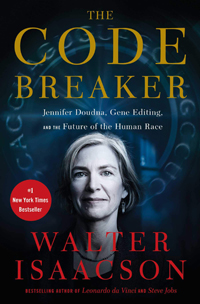 Walter Isaacson, The Code Breaker: Jennifer Doudna, Gene Editing, and the Future of the Human Race (New York: Simon and Schuster, 2021), 560pp.
Walter Isaacson, The Code Breaker: Jennifer Doudna, Gene Editing, and the Future of the Human Race (New York: Simon and Schuster, 2021), 560pp.
A review by Brad Keister, former Deputy Division Director of the Physics Division for the National Science Foundation. In 2018, Brad retired from the more formal demands of research and teaching, and lives in northern Virginia.
Since his earlier career as editor of Time and as CEO of CNN, Walter Isaacson has produced a stream of biographies that chronicle the contributions of individuals who have changed our view of the world, including Leonardo da Vinci, Benjamin Franklin, Albert Einstein, and Steve Jobs. In The Code Breaker, Isaacson explores the recent revolutionary advances in our ability to manipulate the genetic code, and in the process follows the life of Jennifer Doudna, one of the trailblazers, together with her colleagues and competitors.
The story begins when, in the sixth grade, Doudna discovered that her father had placed a copy of James Watson's autobiography The Double Helix: A Personal Account of the Discovery of the Structure of DNA (1968) on her bed. It captured her imagination, and she then aimed for a career to learn about life’s basic elements. As a relatively young scientist, she and her collaborators learned that bacteria could defend against an attacking virus by storing some of the viral genetic code in its own DNA. Doudna and her group then duplicated the process (now carrying the acronym CRISPR) in the lab, but then discovered that one could design the process to target virtually any DNA sequence. That discovery led to the 2020 Nobel Prize in Chemistry, awarded to Doudna and her collaborator in Paris, Emmanuelle Charpentier.
Isaacson brings out the drama of the scientific process itself, and what motivates its practitioners, with a nuanced, page-turning narrative. Scientists pursue their goals with a passion because of the beauty of what they find, not simply to record data. They can sense when they are on the verge of a major discovery, at which point they pour their energies into their work. There are both failures and blind alleys as well as successful milestones. As with their passions, other human factors come into play, including the shadow of competitors (notably Feng Zhang of the Broad Institute of Harvard and MIT), the desire for recognition, as well as matters of trust, which can be fragile.
The advances over the past decade have now opened the opportunity to edit the DNA sequence in humans. This has led to many research efforts aimed to eliminate genetically based diseases, such as sickle-cell anemia. But with this also comes the realization that one can in principle edit any gene — disease related or not — when a human is but a single cell. At that point all future cells in the body will contain the same modified DNA, which in turn can be inherited. This has generated foundational ethical questions that are now being debated across the biomedical community, and Isaacson tries to shape the basic issues so that a reader can follow subsequent developments.
The narrative was interrupted in early 2020 when the COVID-19 pandemic struck the world. Rather quickly, the key players — re eased, and data and results shared at an unusual level. The results have included a relatively cheap way to make a test kit using CRISPR technology, and the first major vaccines ever to use RNA rather than killed virus to allow the body to attack the key proteins of the COVID-19 virus more efficiently, all within a time frame that would have been years long using earlier technologies.
This book is a fitting testament to the beauty of life’s building blocks, the joy of discovery, and the profound societal impact that exploring our world can ultimately provide. For more on gene-editing, see the JWJ review of the book by Henry T. Greely, CRISPR People: The Science and Ethics of Editing Humans (2021).
Dan Clendenin: dan@journeywithjesus.net


